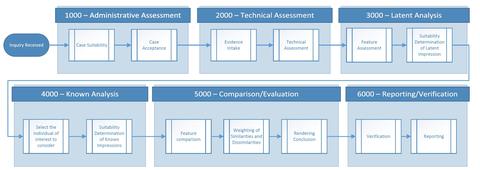
Overview of the friction ridge examination process map.
The Organization of Scientific Area Committees (OSAC) for Forensic Science’s Friction Ridge Subcommittee has developed a friction ridge examination process map that describes the conventional process for latent print examination.
The process map identifies key decision points in the fingerprint examination process, enables laboratory managers to better understand how their protocols compare with those of other laboratories, and provides a framework for developing future standards and best practice documents.
“This map, which captures the ‘as is’ state of friction ridge examination, provides a baseline illustration of the complexity of the process and need for consistency across the forensic science community. Now that this map is in place, we can have a shared vantage point of the process and work together in identifying critical gaps, eliminating inefficiencies, and standardizing the process of friction ridge examination throughout the nation,” said Henry Swofford, Chair of OSAC’s Friction Ridge Subcommittee.
The friction ridge process map, originally published in 2012, was first created by the National Institute of Standards and Technology (NIST) and National Institute of Justice (NIJ) Expert Working Group on Human Factors in Latent Print Analysis. The newly released version describes the various steps of the fingerprint examination process known as ACE-V—short for analysis, comparison, evaluation, and verification. It also describes the different ways that process is currently practiced by the fingerprint examination community.
“As the OSAC Friction Ridge Subcommittee continues to develop standards and best practice recommendations related to the friction ridge examination process, this map will be updated to reflect a single standardized process that is recommended for the friction ridge community,” Swofford said.
Process maps are a useful tool that can help forensic science disciplines provide insight into their specific activities, identify areas for improvement, and discover where standards may be needed. For example, OSAC’s Speaker Recognition Subcommittee developed a process map to document the key components of forensic speaker examination processes in current use. According to David Marks, Chair of OSAC’s Speaker Recognition Subcommittee, “Our hope is that the common understanding captured in the process map will provide a foundation to facilitate efforts to develop future standards and best practice documents.”

